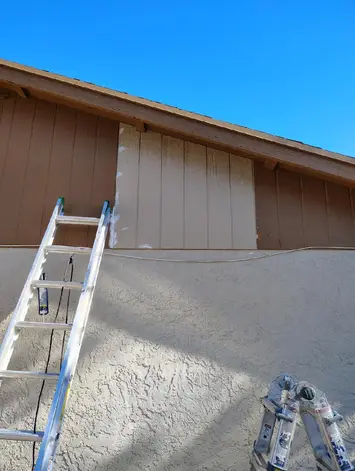Frequently Asked Questions
In Peoria, Arizona, common roofing materials include asphalt shingles, tile, and metal roofing. Each offers different benefits depending on the climate and style of the home.
Yes, metal roofing is a durable and energy-efficient option for homes in Peoria, AZ. It reflects heat and withstands extreme temperatures, making it ideal for the desert climate.
Tile roofing is popular in Peoria (AZ) due to its durability and ability to withstand high heat. It also complements the architectural styles found in the region.
Asphalt shingles are a cost-effective and versatile option in Peoria, Arizona. They provide good protection but may require maintenance sooner due to prolonged sun exposure.
Metal and tile roofing are among the best choices for withstanding the heat in Peoria, AZ. These materials reflect heat and provide excellent longevity.
Yes, flat roofing is often used for commercial properties and some residential homes in Peoria, Arizona. It provides a modern look and is practical for energy-efficient designs.
Tile and metal roofing tend to have the longest lifespan in Peoria (AZ), often lasting several decades with proper maintenance.
Yes, Peoria, AZ homeowners can choose from options like cool roofing, solar tiles, and metal roofs, all of which help reduce energy consumption and reflect heat.
The best roofing material for your home in Peoria, Arizona depends on your budget, home design, and weather conditions. A local roofing expert can help you decide.
It's recommended to inspect your roof in Peoria, Arizona at least twice a year, especially before and after the monsoon season, to catch potential issues early.
Common signs of roof damage in Peoria, AZ include cracked tiles, missing shingles, water stains on ceilings, and sagging areas on the roof.
To prevent leaks during heavy rains in Peoria (AZ), ensure gutters are clear, and have regular inspections to detect cracks or loose roofing materials.
Yes, regular roof cleaning in Peoria, Arizona helps prevent debris buildup, mold growth, and extends the life of your roof.
In Peoria, AZ, using reflective coatings and choosing UV-resistant roofing materials can help protect your roof from sun damage and reduce heat absorption.
If you spot a roof leak in Peoria (AZ), place a bucket to catch water and contact a roofing professional immediately to assess and repair the damage.
Yes, clogged gutters can lead to water overflow, causing damage to your roof and foundation in Peoria, Arizona. Regular cleaning is essential.
The safest way to remove debris from your roof in Peoria, AZ is to use a leaf blower or hire a professional to avoid damaging roofing materials.
Regular inspections, prompt repairs, and using quality roofing materials are key to extending the lifespan of your roof in Peoria (AZ).
Monsoon storms can cause wind and water damage to roofs. Loose shingles, clogged gutters, and pooling water are common issues during this season.
Yes, prolonged exposure to high temperatures can cause roof materials to crack or deteriorate faster, reducing their lifespan.
Clay tiles, metal, and reflective roofing materials perform best in Peoria’s desert climate, helping to withstand heat and UV exposure.
Secure loose shingles, trim overhanging branches, and ensure proper roof installation to minimize wind damage during storms.
Hail can crack tiles, dent metal, and tear asphalt shingles. Regular inspections after hailstorms are essential to detect damage early.
UV radiation accelerates roof material degradation. Reflective coatings and UV-resistant materials can help extend roof longevity.
Heavy rains can lead to leaks, water pooling, and weakened structures. Proper drainage and regular inspections help mitigate these risks.
Fading, curling, or cracking shingles are common signs of sun damage in Peoria. Regular maintenance can help identify and address these issues.
Dust can accumulate and clog gutters, reducing water drainage and leading to leaks. Regular roof cleaning prevents buildup and maintains performance.
A typical roof in Peoria, Arizona lasts between 20 to 30 years, depending on the material and weather conditions.
Tile and metal roofs generally have the longest lifespan in Peoria, often lasting 40-50 years with proper maintenance.
Regular maintenance, cleaning, and inspections can help extend the lifespan of your roof by preventing small issues from becoming larger problems.
Extreme heat, UV exposure, monsoon winds, and dust storms are key factors that can impact roof durability in Peoria, Arizona.
Yes, regular maintenance such as sealing cracks, replacing damaged shingles, and cleaning debris significantly improves roof durability and prevents costly repairs.
Yes, metal roofs are generally more durable than shingles in Peoria due to their resistance to heat, fire, and wind.
Roof inspections are recommended at least twice a year, especially after monsoon season, to ensure durability and catch early signs of damage.
Yes, roof coatings can protect against UV damage, reduce heat absorption, and extend the lifespan of roofs in Peoria.
The intense heat, UV exposure, and occasional storms in Peoria can shorten roof longevity without proper materials and maintenance.
Tile, metal, and cool roofing materials are ideal for energy efficiency in Peoria, AZ, as they reflect heat and reduce indoor temperatures.
Solar panels reduce energy costs by generating renewable power while providing shade to your roof, lowering overall heat absorption.
Yes, cool roofing can significantly reduce cooling costs during Peoria’s hot summers by reflecting more sunlight and absorbing less heat.
Proper roof ventilation helps regulate attic temperatures, preventing heat buildup and lowering air conditioning costs, especially in hot climates like Peoria.
Yes, many roofing options use recycled materials such as metal and composite shingles, which are durable and sustainable, reducing environmental impact.
Reflective roofing materials lower roof surface temperatures by reflecting UV rays, reducing the urban heat island effect and decreasing cooling needs.
Installing solar panels, using cool roofing, and choosing recycled materials are effective upgrades to reduce your roof's carbon footprint.
While green roofs are more common in cooler climates, drought-resistant green roofs can be designed to provide insulation and reduce energy use in Peoria.
Roof insulation reduces heat transfer, keeping your home cooler in the summer and warmer in winter, leading to lower energy consumption year-round.



